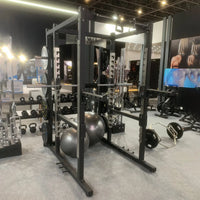Barbell training is a cornerstone of strength training, offering unmatched benefits for building muscle, improving athletic performance, and boosting overall fitness. Despite its popularity, barbell training is surrounded by myths that often discourage beginners or lead to ineffective workouts.
In this article, we’ll debunk common barbell training myths, clarify misconceptions, and provide actionable insights to help you maximize your strength gains.
Myth 1: Barbell Training Is Only for Bodybuilders and Powerlifters
The Reality: Barbell Training Is for Everyone
While bodybuilders and powerlifters rely heavily on barbells, this training method benefits individuals at all fitness levels. Barbell exercises target multiple muscle groups, improve functional strength, and enhance athleticism, making them ideal for:
- Beginners: Building a foundation of strength and coordination.
- Athletes: Enhancing power and performance in sports.
- Everyday Fitness Enthusiasts: Improving posture, metabolism, and overall health.
Takeaway:
Barbell training isn’t exclusive—it’s adaptable to your goals and fitness level, whether you’re lifting for general fitness or peak performance.
Myth 2: Barbells Are Dangerous for Beginners
The Reality: Unsafe Techniques, Not Barbells, Cause Injuries
Barbells are no more dangerous than other equipment when used correctly. Injuries often result from poor form, lifting too much weight, or skipping warm-ups.
How to Stay Safe:
- Start Light: Use an empty barbell to practice form.
- Learn Proper Technique: Focus on mastering foundational exercises like squats, deadlifts, and presses.
- Work with a Trainer: A certified trainer can guide you on proper form and progression.
Takeaway:
Barbell training is safe and effective when approached with the right knowledge and preparation.
Myth 3: Barbell Training Makes Women “Bulky”
The Reality: Building Muscle Doesn’t Equal Bulking Up
Women naturally have lower testosterone levels, making it unlikely for them to build large, bulky muscles from barbell training. Instead, lifting weights helps women:
- Build Lean Muscle: Enhancing tone and definition.
- Burn Fat: Boosting metabolism and promoting fat loss.
- Improve Bone Health: Reducing the risk of osteoporosis through resistance training.
Takeaway:
Barbell training helps women achieve a toned, strong physique without adding unwanted bulk.
Myth 4: Machines Are Safer and More Effective Than Barbells
The Reality: Barbells Offer Unique Benefits Machines Can’t Match
While machines can be useful for isolating muscles or during rehabilitation, they limit natural movement patterns. Barbells, on the other hand, allow for:
- Functional Strength: Mimicking real-world movements and engaging stabilizing muscles.
- Full Range of Motion: Promoting joint health and flexibility.
- Versatility: Supporting a wide variety of exercises and progressive overload.
Takeaway:
Barbells provide a more comprehensive approach to strength training than machines, though both can complement your workouts.
Myth 5: Barbell Training Is Only for Strength, Not Cardio
The Reality: Barbell Complexes Combine Strength and Cardiovascular Training
Barbell exercises like squats, deadlifts, and presses elevate your heart rate, improving cardiovascular fitness. Additionally, barbell complexes—performing multiple exercises back-to-back without rest—are an excellent way to combine strength and cardio.
Example Barbell Complex:
- Deadlift – 6 reps
- Bent-over Row – 6 reps
- Front Squat – 6 reps
- Overhead Press – 6 reps
Takeaway:
Barbell training can enhance both strength and endurance, making it a versatile tool for full-body fitness.
Myth 6: You Need to Lift Heavy to See Results
The Reality: Consistency and Progression Matter More
While lifting heavy weights is beneficial for building maximum strength, you can achieve significant results with lighter weights if you:
- Use Proper Form: Maximize muscle engagement.
- Increase Reps or Sets: Focus on muscular endurance.
- Incorporate Progressive Overload: Gradually increase weight or intensity over time.
Takeaway:
Results come from consistent effort and progression, not just lifting the heaviest weights possible.
Myth 7: Barbell Training Is Bad for Your Joints
The Reality: Proper Technique Protects Your Joints
When performed correctly, barbell exercises strengthen the muscles surrounding your joints, improving stability and reducing injury risk. Issues arise when lifters use improper form, overload weights, or neglect recovery.
How to Protect Your Joints:
- Warm Up: Prepare your muscles and joints with dynamic stretches.
- Use Correct Form: Avoid overextending or twisting your joints.
- Incorporate Rest Days: Allow your body time to recover.
Takeaway:
Barbell training strengthens your joints when done safely, reducing long-term wear and tear.
Myth 8: Barbell Workouts Are Time-Consuming
The Reality: Barbell Training Is Time-Efficient
Barbell exercises, especially compound movements, target multiple muscle groups simultaneously. This means you can achieve a full-body workout in less time compared to isolation exercises.
Time-Saving Barbell Routine:
- Squats – 4 sets of 8 reps
- Deadlifts – 3 sets of 6 reps
- Bench Press – 3 sets of 8 reps
- Overhead Press – 3 sets of 10 reps
Takeaway:
Barbell training delivers efficient, full-body workouts that fit into even the busiest schedules.
Myth 9: Barbell Training Is Only for the Gym
The Reality: Barbell Workouts Are Great for Home Gyms
A simple setup with a barbell, weight plates, and a squat rack can transform any space into a home gym. For those in Dubai or other urban areas with space constraints, compact barbell racks and adjustable weights are excellent options.
Takeaway:
Barbell training is accessible both at the gym and at home with minimal equipment.
Myth 10: Barbell Training Doesn’t Target Core Strength
The Reality: Compound Movements Engage the Core
Barbell exercises like squats, deadlifts, and overhead presses inherently activate your core muscles to stabilize the weight. Adding specific barbell core exercises, such as barbell rollouts, further enhances core strength.
Takeaway:
Barbell training not only builds strength in major muscle groups but also fortifies your core.
Conclusion
Barbell training is one of the most effective methods for building strength, improving fitness, and achieving a well-rounded physique. By debunking these common myths, you can approach your barbell workouts with confidence, ensuring safe and effective progress.
Remember, whether you're lifting for the first time or refining your technique, barbell training is adaptable to your goals and accessible for everyone. Dismiss the myths, embrace the facts, and get stronger with barbell training today!





0 comments